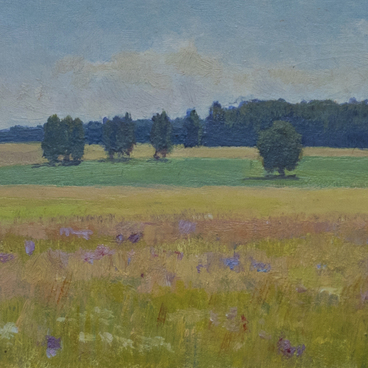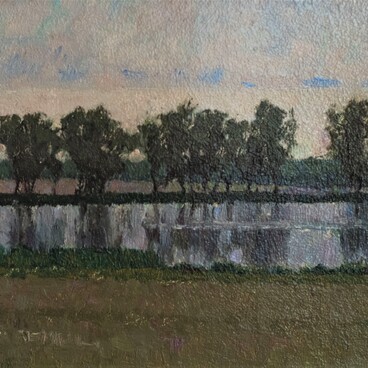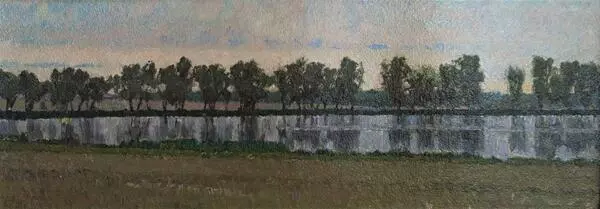The landscape “Winter Sunset” which is housed in the Volzhsky Art Gallery was painted by artist Serafim Zverev in the 1940s. He depicted a snow-covered space with dark contrasting outlines of reeds on the left side of the canvas. In the middle, there is a narrow, dark gray band of dense forest that covers the horizon. The horizon is indicated in the painting only by the perspective of long stripes of clouds which thicken with distance. The evening gray-blue sky with pink reflections creates an atmosphere of silence and tranquility.
Serafim Zverev was a painter, graphic artist, author of mosaics and a talented copyist. He was born in Moscow in 1912 in the family of Alexander Zverev, a priest and teacher. In 1928 Serafim met artists Mikhail Nesterov and Pavel Korin, who later became his teachers and advisors for many years.
Serafim Zverev earned his living by designing city decorations for holidays, and painted large portraits on requests from Moscow district committees. In 1938, the Tretyakov Gallery commissioned him to make a copy of Musorgsky’s portrait and Vasily Surikov’s “Boyaryna Morozova” for traveling exhibitions. In 1952–1953, Zverev created mosaic panels for the Komsomolskaya Koltsevaya subway station, made cardboards for mosaics in the assembly hall of the Moscow State University and in the high-rise building on Rebellion Square, and painted easel portraits of prominent scientists for the new building of Moscow State University.
However, landscape always remained Zverev’s favorite genre. Researchers of his work clearly distinguish between sketches and compositions of the master. The first were created mainly in the beginning of his creative career — in the 1930s and 1940s, when the artist worked exclusively en plein air and tried to convey his own impressions in the paintings.
In Zverev’s sketches of this period, to which the artwork “Winter Sunset” belongs, as a rule, there is no developed composition, but there is always a clearly visible and infinitely distant space, which ends with a clearly marked horizon.
In addition, in the 1930s and 1940s, Zverev never depicted the setting sun in his works, but instead showed the moment when the sun has already set and the sky holds only a memory of the recent bright light.
Zverev devoted the last two decades of his life to his studies of compositional landscapes. Often these landscapes were composite — made on the basis of sketches. Zverev’s goal over time was to create a landscape-composition and a monumental landscape.
Serafim Zverev was a painter, graphic artist, author of mosaics and a talented copyist. He was born in Moscow in 1912 in the family of Alexander Zverev, a priest and teacher. In 1928 Serafim met artists Mikhail Nesterov and Pavel Korin, who later became his teachers and advisors for many years.
Serafim Zverev earned his living by designing city decorations for holidays, and painted large portraits on requests from Moscow district committees. In 1938, the Tretyakov Gallery commissioned him to make a copy of Musorgsky’s portrait and Vasily Surikov’s “Boyaryna Morozova” for traveling exhibitions. In 1952–1953, Zverev created mosaic panels for the Komsomolskaya Koltsevaya subway station, made cardboards for mosaics in the assembly hall of the Moscow State University and in the high-rise building on Rebellion Square, and painted easel portraits of prominent scientists for the new building of Moscow State University.
However, landscape always remained Zverev’s favorite genre. Researchers of his work clearly distinguish between sketches and compositions of the master. The first were created mainly in the beginning of his creative career — in the 1930s and 1940s, when the artist worked exclusively en plein air and tried to convey his own impressions in the paintings.
In Zverev’s sketches of this period, to which the artwork “Winter Sunset” belongs, as a rule, there is no developed composition, but there is always a clearly visible and infinitely distant space, which ends with a clearly marked horizon.
In addition, in the 1930s and 1940s, Zverev never depicted the setting sun in his works, but instead showed the moment when the sun has already set and the sky holds only a memory of the recent bright light.
Zverev devoted the last two decades of his life to his studies of compositional landscapes. Often these landscapes were composite — made on the basis of sketches. Zverev’s goal over time was to create a landscape-composition and a monumental landscape.





